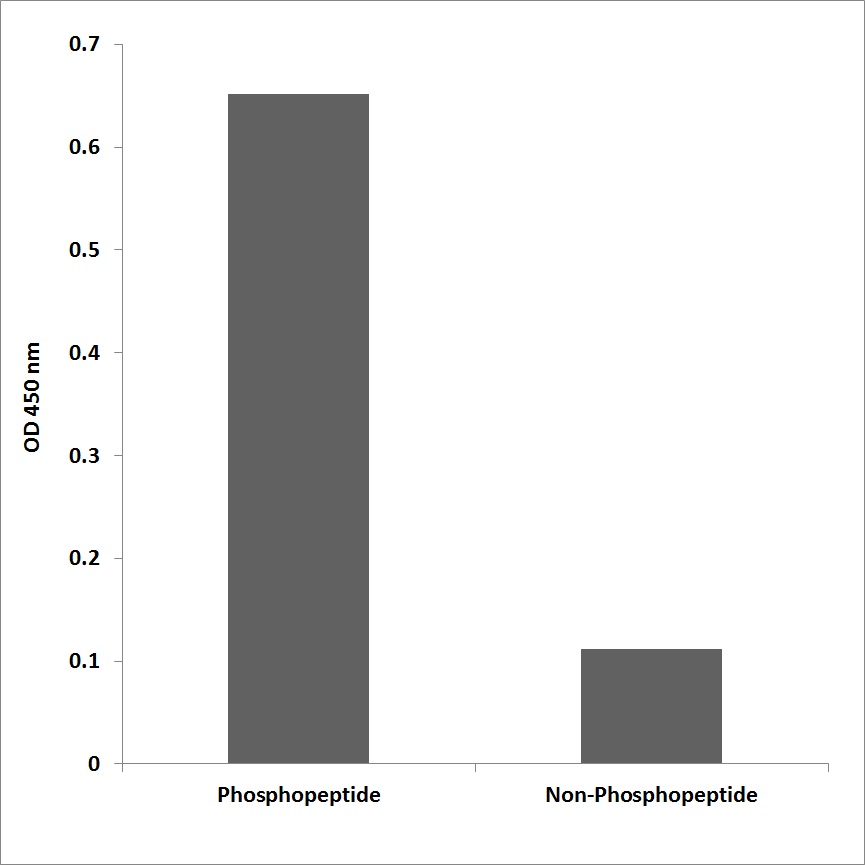Hrs (phospho Tyr216) Polyclonal Antibody
- Catalog No.:YP0132
- Applications:WB;ELISA
- Reactivity:Human;Mouse;Rat
- Target:
- Hrs
- Fields:
- >>Viral life cycle - HIV-1;>>Endocytosis;>>Phagosome
- Gene Name:
- HGS
- Protein Name:
- Hepatocyte growth factor-regulated tyrosine kinase substrate
- Human Gene Id:
- 9146
- Human Swiss Prot No:
- O14964
- Mouse Gene Id:
- 15239
- Mouse Swiss Prot No:
- Q99LI8
- Rat Gene Id:
- 56084
- Rat Swiss Prot No:
- Q9JJ50
- Immunogen:
- Synthesized phospho-peptide around the phosphorylation site of human Hrs (phospho Tyr216)
- Specificity:
- Phospho-Hrs (Y216) Polyclonal Antibody detects endogenous levels of Hrs protein only when phosphorylated at Y216.
- Formulation:
- Liquid in PBS containing 50% glycerol, 0.5% BSA and 0.02% sodium azide.
- Source:
- Polyclonal, Rabbit,IgG
- Dilution:
- WB 1:500 - 1:2000. ELISA: 1:10000. Not yet tested in other applications.
- Purification:
- The antibody was affinity-purified from rabbit antiserum by affinity-chromatography using epitope-specific immunogen.
- Concentration:
- 1 mg/ml
- Storage Stability:
- -15°C to -25°C/1 year(Do not lower than -25°C)
- Other Name:
- HGS;HRS;Hepatocyte growth factor-regulated tyrosine kinase substrate;Hrs;Protein pp110
- Observed Band(KD):
- 115kD
- Background:
- The protein encoded by this gene regulates endosomal sorting and plays a critical role in the recycling and degradation of membrane receptors. The encoded protein sorts monoubiquitinated membrane proteins into the multivesicular body, targeting these proteins for lysosome-dependent degradation. [provided by RefSeq, Dec 2010],
- Function:
- domain:Has a double-sided UIM that can bind 2 ubiquitin molecules, one on each side of the helix.,function:Involved in intracellular signal transduction mediated by cytokines and growth factors. When associated with STAM, it suppresses DNA signaling upon stimulation by IL-2 and GM-CSF. Could be a direct effector of PI3-kinase in vesicular pathway via early endosomes and may regulate trafficking to early and late endosomes by recruiting clathrin. May concentrate ubiquitinated receptors within clathrin-coated regions. Involved in down-regulation of receptor tyrosine kinase via multivesicular body (MVBs) when complexed with STAM (ESCRT-0 complex). The ESCRT-0 complex binds ubiquitin and acts as sorting machinery that recognizes ubiquitinated receptors and transfers them to further sequential lysosomal sorting/trafficking processes. May contribute to the efficient recruitment of SMADs to the
- Subcellular Location:
- Cytoplasm . Early endosome membrane ; Peripheral membrane protein ; Cytoplasmic side . Endosome, multivesicular body membrane ; Peripheral membrane protein . Colocalizes with UBQLN1 in ubiquitin-rich cytoplasmic aggregates that are not endocytic compartments. .
- Expression:
- Ubiquitous expression in adult and fetal tissues with higher expression in testis and peripheral blood leukocytes.
- June 19-2018
- WESTERN IMMUNOBLOTTING PROTOCOL
- June 19-2018
- IMMUNOHISTOCHEMISTRY-PARAFFIN PROTOCOL
- June 19-2018
- IMMUNOFLUORESCENCE PROTOCOL
- September 08-2020
- FLOW-CYTOMEYRT-PROTOCOL
- May 20-2022
- Cell-Based ELISA│解您多样本WB检测之困扰
- July 13-2018
- CELL-BASED-ELISA-PROTOCOL-FOR-ACETYL-PROTEIN
- July 13-2018
- CELL-BASED-ELISA-PROTOCOL-FOR-PHOSPHO-PROTEIN
- July 13-2018
- Antibody-FAQs
- Products Images

- Western Blot analysis of various cells using Phospho-Hrs (Y216) Polyclonal Antibody

- Enzyme-Linked Immunosorbent Assay (Phospho-ELISA) for Immunogen Phosphopeptide (Phospho-left) and Non-Phosphopeptide (Phospho-right), using Hrs (Phospho-Tyr216) Antibody

- Western blot analysis of lysates from A549 cells, using phospho-Hrs (Phospho-Tyr216) antibody.



